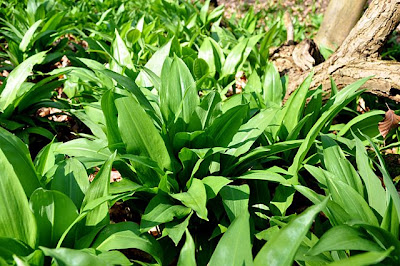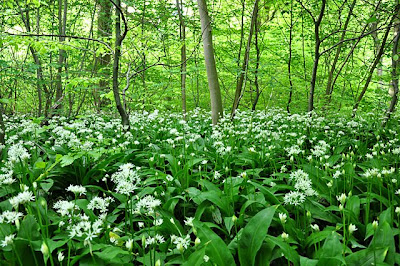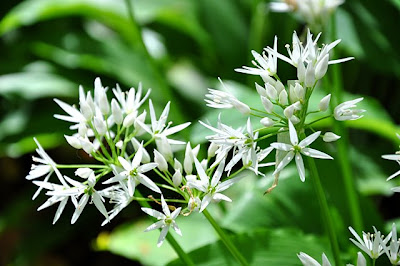This post is very much off the usual topic – now you are warned ;-)

Ramsons basking in the spring sun
Spring has finally arrived in Denmark and is being heralded by one of its early messengers: ramsons. Ramson (Allium ursinum) (also known as buckrams, wild garlic, broad-leaved garlic, wood garlic, and bear's garlic) is a wild relative of chives and grows in deciduous woodlands – fortunately such a forest is located only a couple of kilometers from where I live.

Ramsons covering the forest floor
Ramson is easily distinguished from other plants of the forest by the distinctive, garlicky smell of its leaves. On calm warm days, during the ramson season, the whole forest is enveloped in a cloud of mild garlic odors. When the plants flower the smell can grow really intense – some might even refer to it as a pungent stench ;-)

Carpet of ramsons

Ramson leaves, close-up
When not flowering, the extremely poisonous Lily of the Valley (Convallaria majalis) might be mistaken for ramsons – fortunately you can tell ramson by its smell ;-) All parts of ramson are edible and make for a great supplement to your spring menu.

Lesser celandine flower, close-up
Another messenger of spring in many Danish deciduous forests is the lesser celandine (Ranunculus ficaria (syn. Ficaria verna)) (also known as fig buttercup, and fig wort). Their extremely shiny, looking almost plastic-like, yellow flowers and lustrous dark-green heart-shaped leaves make these plants stand out on the spring forest floor.

Lesser celandine
Last but not least, I must mention the white anemone (Anemone nemorosa) (also known as wood anemone, windflower, thimble weed, and smell fox) – in select locations the anemones virtually blanket the forest floor.

Wood anemone flower, close-up

Wood anemone blanket

Flowering wood anemones
In a few weeks the canopy will be covered in foliage again – until then the dwellers of the forest floor rule.

Forest overlooking the Aarhus bay
Update - May 11, 2009
The deciduous forest is now almost fully leafed-out and it is time for the ramsons to flower.

Flowering ramsons covering the forest floor
The older leaves tend to have a more pungent smell than the small, younger ones and if you trample through a stand of flowering ramsons the garlicky odor can be really overwhelming.

Ramsons flower, close-up
As all other parts of ramsons the flowers may also be eaten and are said to make an interesting garnish for salads – I haven't tried that though.
Malpighia 1927 v.30 (added: 11/24/2025)
-
*By:*
Borzi, Antonino,1852-1921.
Penzig, O.1856-1929.
Pirotta, Romualdo,1853-1936.
*Publication Info:*
Messina : g. Capra & co., 1887-89 ; Genova : Tip. di A...
2 weeks ago



















No comments:
Post a Comment